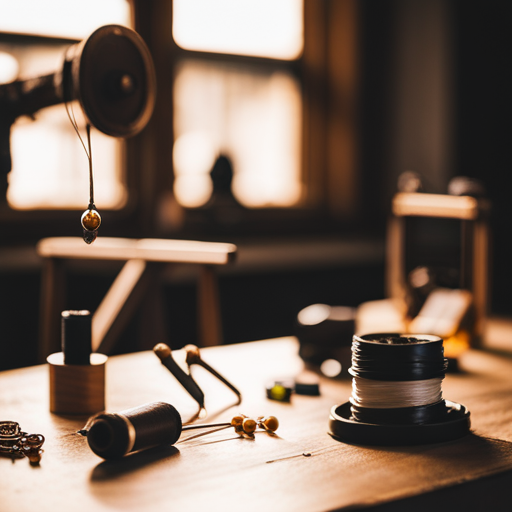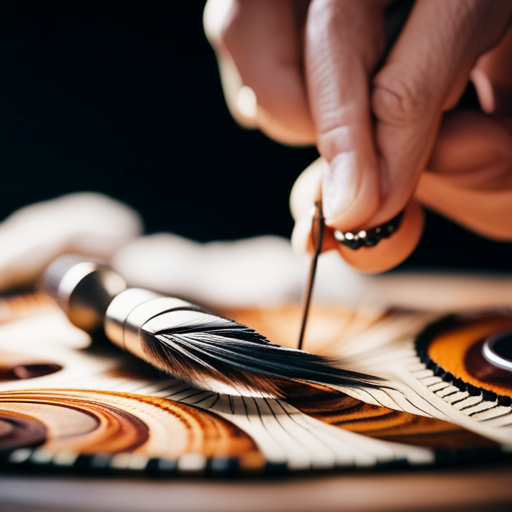Time is of the essence in the art of fly tying, and efficiency is key to producing quality flies. This article provides essential tips and techniques for streamlining your tying process, saving you valuable time and improving your overall productivity.
From material organization to thread and wire techniques, this guide offers experienced insights to help you tie flies quickly and efficiently.
Discover expert advice to enhance your fly tying skills and maximize your time at the tying bench.
Essential Fly Tying Tools
When it comes to efficiently tying flies, having essential fly tying tools is crucial for achieving professional results. Tool maintenance is a key aspect of ensuring that your tools function optimally. Keeping your tools clean and lubricated will not only extend their lifespan but also ensure that they perform at their best. Regularly inspecting tools for any signs of wear and tear and addressing any issues promptly will help maintain their effectiveness.
In addition to tool maintenance, material storage is also important in the fly tying process. Proper storage of materials such as feathers, fur, and synthetic materials is essential for preserving their quality and usability. Keeping these materials in a cool, dry place, away from direct sunlight and moisture, will prevent them from deteriorating and becoming unusable. Organizing materials in a systematic manner, such as using storage containers or drawers, will not only keep your fly tying area neat and tidy but also make it easier to locate specific materials when tying flies.
Time-Saving Material Organization
Effective material organization is essential for streamlining the fly tying process and maximizing efficiency. Properly organized materials not only contribute to a neat and tidy workspace but also facilitate quick access to specific materials, ultimately saving time during fly tying sessions.
To achieve efficient material storage, consider using clear, stackable containers or compartmentalized organizers to keep feathers, fur, and other materials sorted and easily accessible. Utilizing a labeling system can further streamline material retrieval.
For thread organization, a thread stand or rack can prevent entanglement and ensure quick access to various thread colors and types.
A well-organized and efficient workspace will help reduce the time spent searching for materials, allowing for better time management during fly tying. Additionally, having materials and tools within reach helps maintain focus and momentum, making the overall tying process more enjoyable and productive.
Efficient Thread and Wire Techniques
The proper utilization of thread and wire techniques is crucial for achieving efficient and precise fly tying. Effective thread management is key to minimizing waste and ensuring a smooth tying process. When working with thread, it’s essential to maintain consistent tension and avoid excessive buildup, which can add unnecessary bulk to the fly. Utilizing techniques such as figure-eight wraps and thread control methods can help in achieving neat and secure fly patterns while minimizing thread usage.
Incorporating wire wrapping techniques is another essential aspect of efficient fly tying. When using wire for ribbing or creating durable bodies, it’s important to maintain even spacing and tension to achieve the desired effect. Utilizing techniques such as counter-ribbing and secure wire anchoring can streamline the process and enhance the overall durability of the fly pattern.
Quick Tips for Proportions and Symmetry
Achieving proper proportions and symmetry in fly tying is essential for creating well-balanced and visually appealing patterns. To ensure your flies are well-proportioned and symmetrical, consider the following quick tips:
-
Proportion Control:
-
Use a reference hook to measure the correct length of materials, ensuring consistency across flies.
-
Adjust material amounts and placement to match the natural proportions of the fly you are imitating.
-
Regularly step back and visually assess the proportions to make necessary adjustments before finalizing the fly.
-
Symmetry Techniques:
-
Secure materials centrally on the hook shank to maintain symmetry.
-
Use the hook eye as a guide for aligning materials along the centerline of the fly.
-
Check for symmetry at each tying stage to correct any deviations before progressing.
By implementing these proportion control and symmetry techniques, you can enhance the visual appeal and effectiveness of your fly patterns.
Moving on to the next section, let’s delve into streamlined hackle and feather handling for further efficiency in fly tying.
Streamlined Hackle and Feather Handling
When it comes to fly tying, efficient feather handling techniques can make a significant difference in the speed and quality of your flies.
Time-saving hackle methods and neat, quick wrapping are essential skills for achieving streamlined and professional-looking patterns.
Efficient Feather Handling Techniques
To achieve efficient feather handling techniques, one must focus on precision and controlled movements when working with feathers for fly tying. When handling feathers, consider the following:
-
Feather selection: Choose feathers that match the size and color required for the specific fly pattern. Look for feathers with uniform barb length and minimal fraying to ensure a neat and professional finish.
-
Wrapping techniques: Use consistent and even tension when wrapping feathers around the fly’s hook shank. This will create a smooth and uniform body with the desired density. Avoid over-wrapping, as it can lead to bulkiness and affect the fly’s buoyancy and movement in the water.
-
Controlled trimming: Trim excess feather material with sharp scissors in small, deliberate cuts to achieve clean edges without damaging the feather’s integrity.
Following these techniques will streamline the process and result in professionally crafted flies.
Time-Saving Hackle Methods
How can fly tyers streamline their hackle and feather handling to save time without compromising quality?
When it comes to time-saving hackle methods, efficient feather selection is key. Choose feathers that match the size and shape needed for the fly pattern to minimize trimming and manipulation. Additionally, consider pre-sorting feathers by size and type to expedite the selection process.
When it comes to hackle application, consider using hackle pliers to firmly grip the feather and facilitate precise wrapping. This not only saves time but also ensures a clean and consistent application.
Another time-saving tip is to strip the lower fibers of the feather before tying it in, reducing bulk and simplifying the wrapping process.
Neat and Quick Wrapping
Efficient feather selection and precise wrapping techniques are essential for achieving neat and quick wrapping in fly tying, ensuring a streamlined hackle and feather handling process. To achieve a quick whip and tidy finish, follow these tips:
- Choose feathers with minimal webbing and consistent barbule length to ensure smooth and even wrapping.
- Pre-sort and prepare feathers in advance to minimize handling time during the tying process.
- Use a rotary vise to efficiently wrap feathers around the hook shank, allowing for quick and precise wrapping with minimal hand movement.
- Utilize hackle pliers to securely hold feathers during wrapping, ensuring a tidy finish and preventing slippage.
Speedy Finishing and Head Cement Application
When it comes to finishing off a fly, precise head cementing techniques can make all the difference in terms of durability and aesthetics.
Time-saving finishing methods are essential for efficient fly tying, allowing for a quicker turnaround without sacrificing quality.
Implementing efficient fly tying strategies can help streamline the overall tying process and improve productivity.
Precise Head Cementing Techniques
Implementing precise head cementing techniques is essential for achieving speedy finishing and accurate head cement application in fly tying. When applying head cement, using a brush application ensures even and controlled distribution, while allowing for precise drying. Additionally, opting for a quick head coating technique not only saves time but also results in a smooth finishing. To further enhance precision, using a fine-tip applicator for small flies or a bodkin for larger patterns can help in achieving the desired results. Moreover, ensuring that the head cement is applied sparingly can prevent excessive build-up, resulting in a neat and professional appearance. These techniques are indispensable for achieving efficient and precise head cement application in fly tying.
When it comes to time-saving finishing methods, there are several strategies that can streamline the tying process.
Time-Saving Finishing Methods
To expedite the fly tying process, employing efficient head cementing techniques is crucial for achieving a polished and professional appearance. Quick whip finishing and efficient epoxy application are essential for saving time.
When finishing flies, using a whip finishing tool can significantly speed up the process, ensuring a secure knot without the need for excessive wraps.
Additionally, employing efficient epoxy application techniques can save time and ensure a smooth, durable finish. Time-saving UV resin is another great option for finishing flies quickly, as it cures instantly when exposed to UV light, eliminating the need for drying time.
Furthermore, incorporating fast dubbing techniques can also help streamline the fly tying process, allowing for quick and efficient application of dubbing materials to create lifelike and attractive fly patterns.
Efficient Fly Tying Strategies
For achieving quick and efficient fly tying, employing precise head cement application and speedy finishing strategies is essential.
-
Speedy Finishing Strategies
-
Organize materials for easy access
-
Utilize pre-made fly tying templates for consistent sizing
-
Practice efficient hand movements to minimize tying time
-
Precise Head Cement Application
-
Use a fine-tipped applicator for accurate and controlled cement application
-
Apply a thin, even layer of head cement to ensure durability without excess bulk
-
Let the head cement dry completely before handling the fly
By incorporating these techniques, fly tyers can streamline their tying process, allowing for greater productivity without compromising quality.
Efficient fly tying strategies are crucial for maximizing productivity and enjoying more time on the water perfecting fly fishing techniques and fly selection.
Frequently Asked Questions
What Are Some Common Mistakes to Avoid When Tying Flies Quickly and Efficiently?
When aiming for efficient fly tying, avoiding common mistakes is crucial. Incorporating time-saving techniques, improving efficiency, and effectively managing materials are essential. Careful planning, organization, and attention to detail are key for successful and quick fly tying.
Are There Any Specific Techniques for Tying Different Types of Flies, Such as Dry Flies, Nymphs, or Streamers, More Quickly?
To achieve efficient material handling and quick tying across different styles of flies, mastering specific techniques is essential. From precise thread management to streamlined pattern assembly, these techniques ensure efficient and quick fly tying results.
How Can I Improve My Fly Tying Speed Without Sacrificing Quality?
To improve fly tying speed without sacrificing quality, focus on efficient time management and meticulous quality control. Streamline your workflow by organizing materials, using time-saving techniques, and consistently assessing the precision of each tie.
What Are Some Strategies for Managing Different Types and Sizes of Materials to Save Time and Stay Organized?
In managing different materials for efficient fly tying, strategic organization is crucial. Categorizing materials by type and size, utilizing clear containers, and labeling systems can save time and maintain order. These practices enhance productivity and streamline the tying process.
Are There Any Shortcuts or Time-Saving Tricks for Dealing With Tricky Materials Like Hackle and Feathers?
When dealing with tricky materials like hackle and feathers, time-saving hacks and efficient workflows are crucial. Quick tying tips and effective material management ensure smooth, productive fly tying. Incorporating these strategies optimizes efficiency and enhances the tying experience.
Conclusion
In conclusion, mastering quick and efficient fly tying techniques is like fine-tuning the strings of a violin, creating a harmonious and precise result.
By utilizing essential fly tying tools, organizing materials, and employing efficient techniques, fly tiers can streamline their tying process and produce high-quality flies with speed and precision.
With practice and experience, fly tiers can achieve a level of proficiency that allows for quick and efficient tying.




